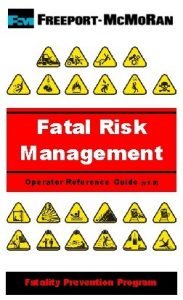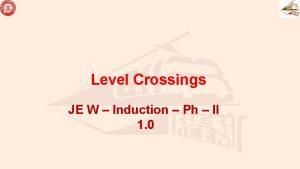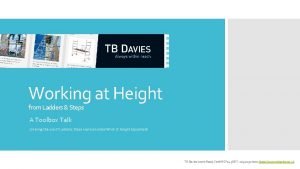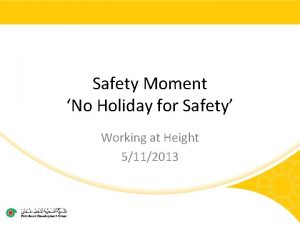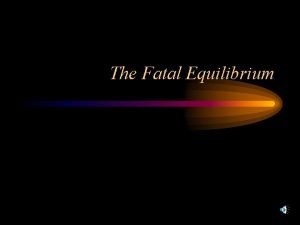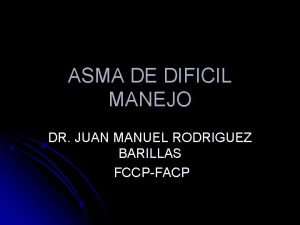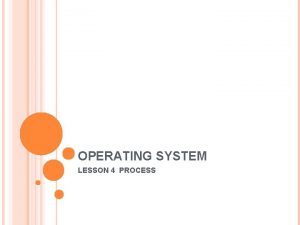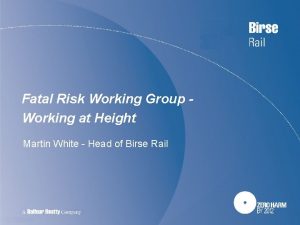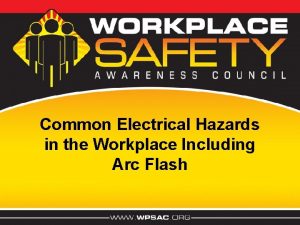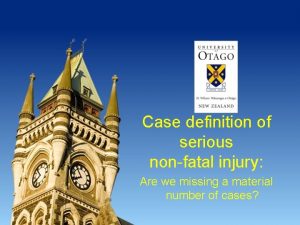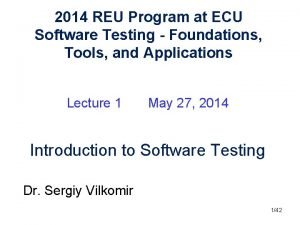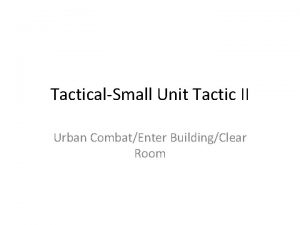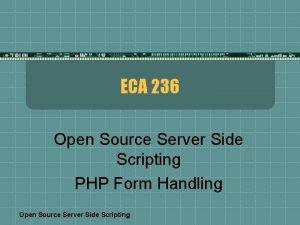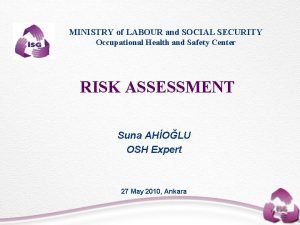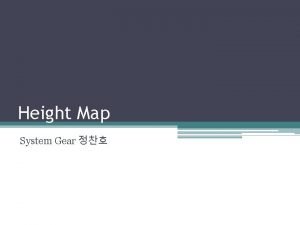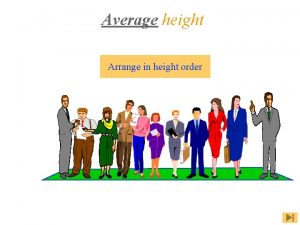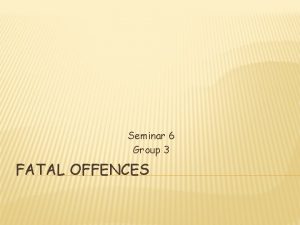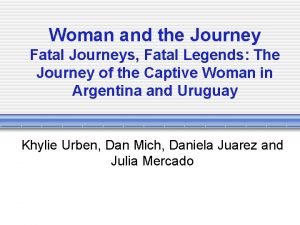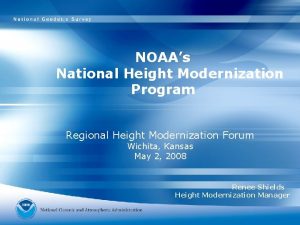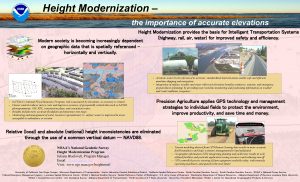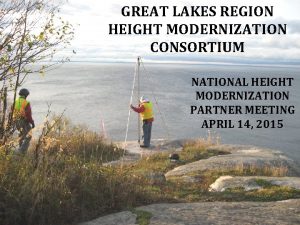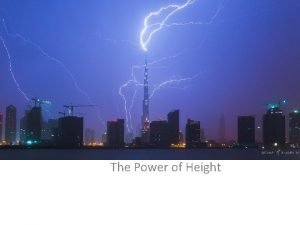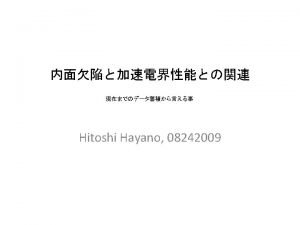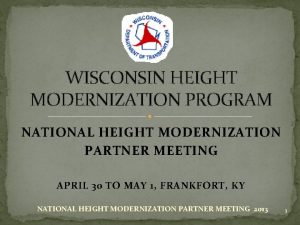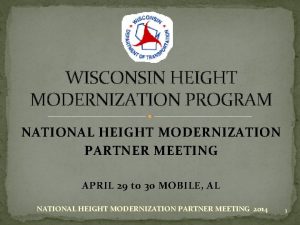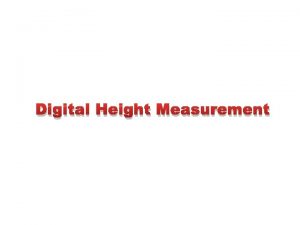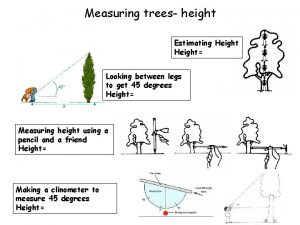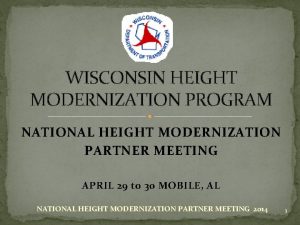Fatal Risk Working Group Working at Height Martin







































- Slides: 39

Fatal Risk Working Group Working at Height Martin White - Head of Birse Rail

Introduction Birse are now part of Balfour Beatty Rail Now part of Projects business unit Beginning of a journey in BB Rail Part of Zero Harm in Balfour Beatty Zero AFR for most of last year The Golden Rules

The Golden Rules

Fatal Risk Working Group Zero Harm Journey Plan Balfour Beatty Rail fatal risk working groups − Electrical Safety − Working at Height − On Track Plant Safety − Materials Handling − Driver Risk Management Led by an Executive Team member

Why? Our fatal risks remain in this category − Many Hi. Pos or close calls here Our statistics are nowhere near Zero Harm We are not in sight of making our work at height risk free We’ve come a long way but not far enough

What is WAH? Anything where a person could be injured from someone or something falling, regardless of: − the duration − equipment being used − the physical distance involved. Includes: − access to and egress from the work area − falling objects

Holiday snaps?





Closer to home?





Even closer to home


Who are we? Martin White – Head of Birse Rail Mick Davies – SHE Manager Rail Projects Adam Nolan – Planner James Mather – Graduate Engineer Jim Nabarro – Specialist Rail Plant Manager Richard Morgan – Birse Contracts Manager Ron Foster – Rail Projects Project Manager

Statistics 4 In 2008 there were 329 fatalities in the US Construction industry related to falls from height 4 In 2008 there were 21 fatalities and 1, 200 major injuries in the UK Construction industry related to falls from height 4 Between January 2007 and January 2010 in Balfour Beatty there were 594 incidents related to work at height, of which 71 were major injuries and 3 were fatalities 4 Between October 2008 and January 2010 in Balfour Beatty there were 230 incidents involving falling objects, of which 17 were major injuries and four involved third parties and members of the public

Statistics Birse Rail had 10 incidents relating to Working at Height in 2010: 8 near misses / close calls 1 injury (requiring medical attention) 1 Prohibition Notice

Working at Height Group – Our Remit Ensure WAH risks are managed − Failure is not an option Improve BB Rail processes for controlling WAH Reduce WAH risk by − Avoiding it − Finding alternative solutions − Providing even better controls

Key WAH Risk Areas for BB Rail On Track Plant – maintenance and repair Access to wagons for loading/unloading Demolition Civils and building activities OLE installation Use of MEWPS Signal gantries – erection/maintenance Trestles/Scaffolding/mobile towers

Can we eliminate working at height completely? Falls from height and falling objects risks − Balfour Beatty employees − Other Contractors − Third parties and members of the public To do so we need others to help

What are we going to do? Identify the key risk areas Define the problem Find best practice from BB Opcos and suppliers Instruct people “how to do it” (not how not to do it!) Have a “reality check” with those at risk. Check that we propose will actually work − In our environment

Planning Proper planning is essential (6 P Principle) All activities potentially involving work at height must be − identified − the risks systematically assessed − risk reduction planned in advance Work at height should be avoided whenever possible.

Objectives Avoid the need to work at height − Change design of structure or process Reduce the number of people who work at height − Increase off site manufacture. Reduce the likelihood of a fall − Use podium steps rather than a ladder Reduce the consequences if falls do occur − Fall arrest systems including a system for recovery

How and when are we going to do it? Gather information (January) Collate best practice (February) Review on site working practices (February) Apply our ideas (March) Compose solutions (April – May) Reality check and cost check (May) Identify training needs (May) Implement (June)

Best Practice

Vehicle edge protection

Load strapping

Ceiling access

Cabin lifting

Vacuum lifting of precast units

Feet on the ground campaign 4 Assume that all work will be conducted with feet on the ground. 4 Where this cannot be achieved, then the “ground” is brought up to the level of the activity, e. g. by using a MEWP.


What are our challenges? Proper engagement with the workforce − Both ways Behaviour of − our employees − our sub-contractors − our clients Over complication in our solutions Cost of solutions

Long Term Success Reduced risks posed by WAH Reduced accidents and Hi. Pos Recognition from our end users − workable solutions in place The workforce says it’s better Zero Harm at height

Any questions?
 Fatality risk management
Fatality risk management Credit risk market risk operational risk
Credit risk market risk operational risk Tvu of level crossing
Tvu of level crossing Toolbox talk working at height
Toolbox talk working at height Safety has no holiday
Safety has no holiday Smart work and hard work
Smart work and hard work Hot working and cold working
Hot working and cold working Hot working and cold working difference
Hot working and cold working difference Machining operations
Machining operations Prinsip dasar proses pengerjaan panas yang benar adalah
Prinsip dasar proses pengerjaan panas yang benar adalah The fatal equilibrium
The fatal equilibrium Romeo juliet prolouge
Romeo juliet prolouge Is multiple sclerosis fatal
Is multiple sclerosis fatal 13 fatal errors managers make sparknotes
13 fatal errors managers make sparknotes Fatal if swallowed pictogram
Fatal if swallowed pictogram Asma labil
Asma labil Operating system
Operating system Balfour beatty 6 fatal risks
Balfour beatty 6 fatal risks Fatal approach boundary
Fatal approach boundary Romance de una fatal ocasion
Romance de una fatal ocasion Indicadores verificables objetivamente
Indicadores verificables objetivamente I am not yet born o hear me
I am not yet born o hear me My attitude is fatal
My attitude is fatal Filter if
Filter if Non-fatal injury evaluation
Non-fatal injury evaluation Fatal defect in software testing
Fatal defect in software testing Ambitious nouns
Ambitious nouns Positive corner fed room
Positive corner fed room Unexpected kernel mode trap
Unexpected kernel mode trap Oki fatal error 980 reset
Oki fatal error 980 reset Evaluation of non fatal offences
Evaluation of non fatal offences Fatal error in client side script
Fatal error in client side script Typhon percy jackson
Typhon percy jackson Non fatal offences evaluation
Non fatal offences evaluation Working alone risk assessment example
Working alone risk assessment example Risk projection
Risk projection Avoidance risk
Avoidance risk Absolute risk vs relative risk
Absolute risk vs relative risk Residual risk and secondary risk pmp
Residual risk and secondary risk pmp Inherent risk vs control risk
Inherent risk vs control risk
